The Yellow Submarine Chronicles Part Three: All Together Now!
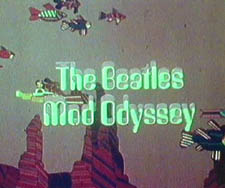 Traditionally, an animated film is scripted, dialog is recorded from this script, and then artwork is produced and filmed to illustrate the story and match the dialog. The process of writing a script for a feature length film can take anywhere from several months to even several years before a final version is completed. By the late 1960’s, no studio, including the industry giant Disney, had ever completed an animated feature in less than two years. With roughly twelve months to deliver a theater ready feature length film based on the Beatles’ music and no concept of a plot, let alone a finished script, it is amazing Al Brodax didn’t run for the hills and hide!
Traditionally, an animated film is scripted, dialog is recorded from this script, and then artwork is produced and filmed to illustrate the story and match the dialog. The process of writing a script for a feature length film can take anywhere from several months to even several years before a final version is completed. By the late 1960’s, no studio, including the industry giant Disney, had ever completed an animated feature in less than two years. With roughly twelve months to deliver a theater ready feature length film based on the Beatles’ music and no concept of a plot, let alone a finished script, it is amazing Al Brodax didn’t run for the hills and hide!
As the project that would become the Beatles third feature film was given the green light and entered into production, Brodax had only one element left from his original plan – TVC Studios. This small animation studio in London had produced the Beatles cartoon show and provided a good start for the film but with the idea of feature length version of the series flatly rejected, they were dead in the water. Without even the slightest thread of a framework or a general conception of tone or style for the film, there was nothing to animate.
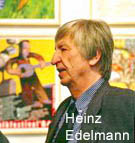 The idea of basing this film on the song Yellow Submarine has been credited to or claimed by at least four different sources including Ringo Starr. Regardless of where the concept originated, this gentle children’s song was overflowing with fantasy elements, including a journey to a land of submarines, which could at least provide some basic direction for the animators. Much like the production of the television series where each script was little more that a set up for the featured song, segments for the motion picture could be produced independently of one another and then strung together using the narrative from the script whenever it finally materialized.
The idea of basing this film on the song Yellow Submarine has been credited to or claimed by at least four different sources including Ringo Starr. Regardless of where the concept originated, this gentle children’s song was overflowing with fantasy elements, including a journey to a land of submarines, which could at least provide some basic direction for the animators. Much like the production of the television series where each script was little more that a set up for the featured song, segments for the motion picture could be produced independently of one another and then strung together using the narrative from the script whenever it finally materialized.
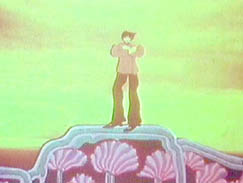 Animation directors George Dunning, Jack Stokes, and Charlie Jenkins were carried over from the television series as part of the TVC staff but to keep the film fresh and distinct from the Saturday morning show, new talent was needed. To oversee the design of the production, Brodax hired Czechoslovakian graphic artist Heinz Edelmann as the art director. Edelmann was a poster artist with a style reminiscent of Peter Max and a pronounced dislike for the corporate animation studios such as Disney. In the 1968 documentary Mod Odyssey, Edelmann described his view of the Beatles very broadly. He saw John as a showman, Paul as a young executive, George as a cowboy, and Ringo as a schoolboy Charlie Chaplin! By way of a screen test, Edelmann animated two minutes of footage showing George Harrison standing atop a mountain in a mystical pose with live action film combined at the bottom. This scene was so well received that it was incorporated into the finished film to serve as George’s introduction in the museum.
Animation directors George Dunning, Jack Stokes, and Charlie Jenkins were carried over from the television series as part of the TVC staff but to keep the film fresh and distinct from the Saturday morning show, new talent was needed. To oversee the design of the production, Brodax hired Czechoslovakian graphic artist Heinz Edelmann as the art director. Edelmann was a poster artist with a style reminiscent of Peter Max and a pronounced dislike for the corporate animation studios such as Disney. In the 1968 documentary Mod Odyssey, Edelmann described his view of the Beatles very broadly. He saw John as a showman, Paul as a young executive, George as a cowboy, and Ringo as a schoolboy Charlie Chaplin! By way of a screen test, Edelmann animated two minutes of footage showing George Harrison standing atop a mountain in a mystical pose with live action film combined at the bottom. This scene was so well received that it was incorporated into the finished film to serve as George’s introduction in the museum.
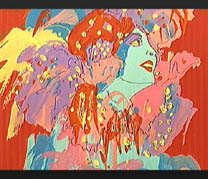 While the Beatles’ entire song catalog was at Brodax’s disposal, a decision was made early on to keep the tunes current. It also made excellent business sense to feature as many songs as possible from the recent smash Sgt. Pepper album. Eleanor Rigby, Lucy in the Sky with Diamonds, and When I’m Sixty-Four were some of the first choices for sequences. These songs were assigned to teams of animators, all with different styles, before anything resembling a script had turned up. The Beatles were also obligated to provide four new musical numbers specifically for the film but these would not be available until later in production. The remaining songs would be chosen as pieces of the story filtered in and some, like Strawberry Fields Forever and Lovely Rita, would later be scrapped in the interest of time and money.
While the Beatles’ entire song catalog was at Brodax’s disposal, a decision was made early on to keep the tunes current. It also made excellent business sense to feature as many songs as possible from the recent smash Sgt. Pepper album. Eleanor Rigby, Lucy in the Sky with Diamonds, and When I’m Sixty-Four were some of the first choices for sequences. These songs were assigned to teams of animators, all with different styles, before anything resembling a script had turned up. The Beatles were also obligated to provide four new musical numbers specifically for the film but these would not be available until later in production. The remaining songs would be chosen as pieces of the story filtered in and some, like Strawberry Fields Forever and Lovely Rita, would later be scrapped in the interest of time and money.
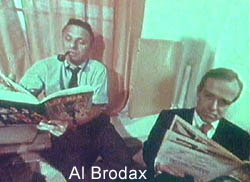 The resources of TVC Studios were quickly overwhelmed by their most ambitious production to date and soon almost every available animator in England was on the payroll furiously churning out footage. Before the film was finished, other studios in Canada,Australia, and Holland would be contracted to help meet the seemingly impossible deadline. Brodax brought in Abe Goodman and Mary Ellen Stewart from his King Features staff in the US to handle the daily business dealings of the operation and the cobbled together cartoon factory moved into high gear to meet a deadline that loomed even before they had started. As the film’s production truly got under way there was still one major problem that had to be addressed and quickly – the lack of a script!
The resources of TVC Studios were quickly overwhelmed by their most ambitious production to date and soon almost every available animator in England was on the payroll furiously churning out footage. Before the film was finished, other studios in Canada,Australia, and Holland would be contracted to help meet the seemingly impossible deadline. Brodax brought in Abe Goodman and Mary Ellen Stewart from his King Features staff in the US to handle the daily business dealings of the operation and the cobbled together cartoon factory moved into high gear to meet a deadline that loomed even before they had started. As the film’s production truly got under way there was still one major problem that had to be addressed and quickly – the lack of a script!
